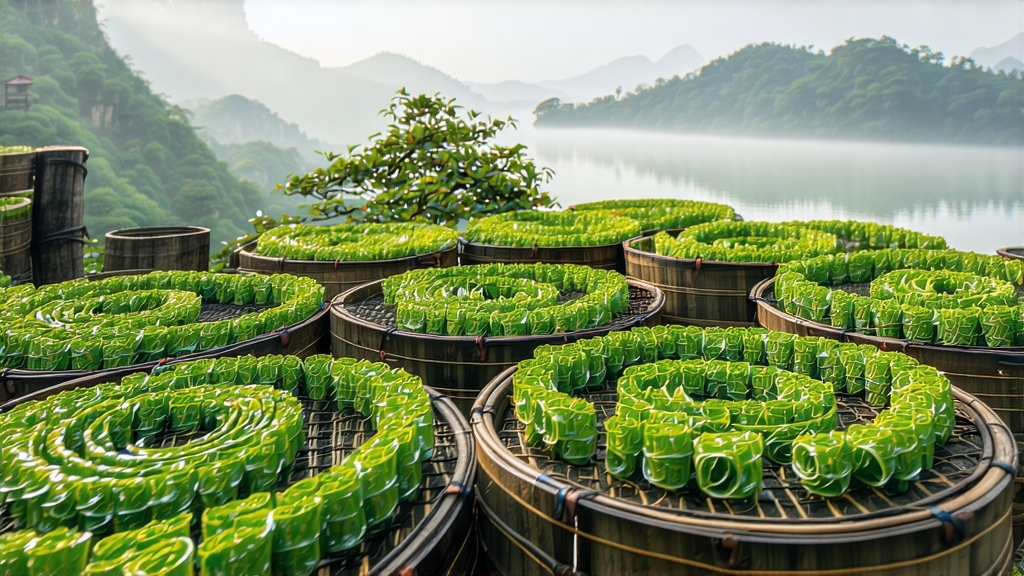
Biluochun, whose name translates literally to “Green Snail Spring,” is one of China’s ten most celebrated teas, yet it remains a delicate secret outside serious tea circles. Grown on the forested islands and peninsulas of East Dongting Mountain in Jiangsu’s vast Taihu Lake, this green tea seduces with a fragrance so naturally fruity that locals still call it “scary fragrance” (xia sha ren xiang) in the local dialect—an affectionate warning that its perfume can be almost too intense for the uninitiated. To understand Biluochun is to listen to a 1,200-year-old conversation between fruit trees, lake mist, and the nimble fingers of pickers who work before the sun burns the dew away.
Historical whispers place Biluochun’s birth during the late Tang dynasty, when tea growers noticed that young leaves growing among peach, plum, and apricot trees absorbed the orchard’s spring bloom scent. By the Ming dynasty the tea had become imperial tribute; the Kangxi Emperor, touring the south in 1699, was so enchanted by the spiraled, jade-green leaf and its shimmering infusion that he bestowed the poetic name “Biluochun,” replacing the humbler market name “Xia Sha Ren Xiang.” The Qing court’s demand refined every step of production, embedding precision into tradition.
Unlike many Chinese greens that prize early March pre-Qingming buds, Biluochun is defined by an even tighter picking window: only the topmost single bud or bud-with-immediate-leaf plucked between Grain Rain (April 20) and the beginning of summer. Pickers begin at dawn, when lake mist keeps leaf temperature low and cellular activity slow, locking in volatile aromatics. A skilled picker gathers barely 500 grams of fresh leaf in four hours—enough, after firing, for just 100 grams of finished tea.
The crafting choreography that follows has changed little since the 17th century. First comes “killing green” (shaqing): leaves are tossed into a drum pan pre-heated to 180 °C for forty seconds, deactivating enzymes that would otherwise invite oxidation. The tea master’s bare hand sweeps across the metal, feeling for the moment leaf temperature drops to 80 °C; at that instant the heat is lowered and the shaping phase begins. Using the “three motions—rub, roll, and push”—the master coaxes each bud into a tight spiral that resembles a snail shell, simultaneously breaking cell walls so sap migrates to the surface. Finally, a gentle charcoal bake at 60 °C for twenty minutes reduces moisture to 5 %, fixing the iconic white downy tips that glisten like frost on spring moss.
Because the leaf is so slender and down-covered, Biluochun demands cooler water than most greens. Bring freshly drawn, low-mineral spring water to 75 °C—just when the first steady columns of steam rise, but before the kettle sings. Use a tall glass or a 150 ml porcelain gaiwan; glass reveals the “dancing” of the spirals as they unfurl. Measure 3 g of leaf (about a level tablespoon) and pour the water along the vessel’s wall to avoid scorching. Steep for 45 seconds; the liquor should glow pale jonquil with a faint silvery rim. Subsequent infusions lengthen by ten seconds each; good Biluochun yields five sweet brews before aroma fades.
To taste like a tea judge, first lift the empty, pre-warmed gaiwan lid and inhale the “dry aroma.” Premium grades release a burst of lychee and ripe peach, a perfume created by terpene alcohols shared with neighboring fruit trees. After the first steep, sniff the lid again: the scent should deepen to nectarine skin and fresh cucumber. Take a sip, hold it for three seconds, then breathe through the nose; the retronasal finish should suggest whipped cream and faint vanilla, a signature of high amino-acid content. Finally, inspect the spent leaves: intact single buds with tiny fish-tail sepals indicate hand-picking; red-edge bruises betray careless machine harvest.
Biluochun is classified into five official grades, but locals simplify to two: Dongshan (island) and Xishan (peninsula). Dongshan leaf grows among more fruit trees, yielding stronger floral notes; Xishan leaf, caressed by lake breezes from three sides, tends toward a softer, marine sweetness. Within each zone, elevation matters: tea picked above 200 m on Dongting’s ridge is called “